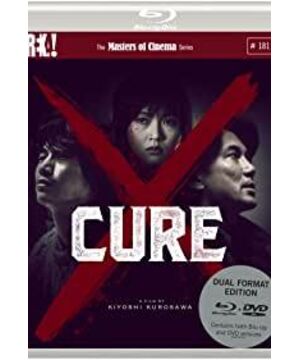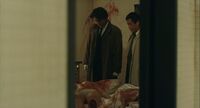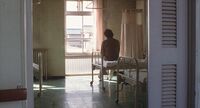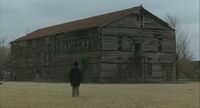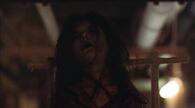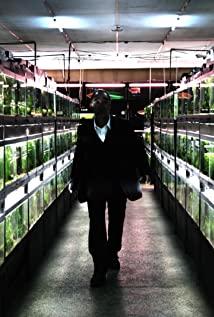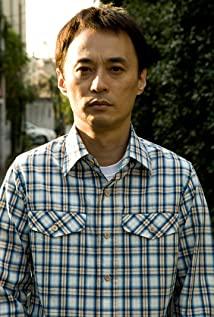On November 27, 2020, Kadokawa released the first Japanese Blu-ray disc of the film, which enabled 4K digital restoration (but the disc is a normal bd not 4Kbd), and the bonus DVD contains 200 minutes of highlights. Most of the content is the previous Eureka. The Blu-ray version does not. The highlight is of course the 80-minute behind-the-scenes documentary "CORE OF CURE" specially edited by Mari Anri. In fact, when I look at it, this film is mainly composed of seven or eight segments of studio work images that have never been made public before, with each segment of the film for comparison (actually, the length of the film is discounted...), interspersed with the 2020 Anri Mari I interviewed the director, the two male protagonists, the director of photography, the two assistants, and the soundtrack. Anri Mari said that he was scared to death when he watched "CURE" in the theater alone in his college days. I really like her video style, but this is not reflected in this documentary. The live video shooting is actually quite boring. The interview may be messy because it has been many years. The bonus is also attached to the full version of the interview with Koji Kurosawa Kiyohagihara Saint Yakusho. The full version used in the documentary is included. However, the actual length of time has been discounted. Compared with the interspersed use, it is more complete. Be organized.
The soundtrack of the feature film commentary is the chat of three people, director Mari Ansato, director Keno Kikuchi (assistant director of "Journey to the Shore"), and screenwriter Hiro Takahashi. There is also a 24p booklet. The paper is thick and thick, and the design is beautiful, but it is not a reproduction of the public screenings, and there is no in-depth interviews with the cast and staff. The amount of information is medium.
Below I have compiled some information from the above content to share with you.
Leak! ! Friends who haven't watched the film, please don't read it! ! !
1. Kiyoshi Kurosawa made it clear that the opportunity that triggered his creation of this film was "The Silent Lambs" (he liked it very much), that is, the prisoner Hannibal who was locked up was more dangerous. Talking to him would cause danger but As a villain who cannot help but question the police, "the beginning of the main story is only after being caught." He also said that he often watched TV to report on certain crimes. At the beginning, he interviewed neighbors and acquaintances who said how ordinary he usually feels. However, follow-up reports often dig out the suspect’s unusual experience and emphasize his hidden specialness, but Kurosawa is clear. I think it might as well assume that "ordinary" is the essential attribute of the offender.
2. The first thing that came out was an 11-page synopsis titled "The Preacher", which was written in 1996, and the full text was reprinted in the Japanese Blu-ray booklet. Since the Aum Shinrikyo incident was very dynamic at the time, the film crew felt that the original title might have caused religious associations to be inappropriate, so it changed to "CURE". Originally set up: Police Detective High was 35 years old, his psychiatrist friend Sakuma was 36 years old, Mamiya was a university psychology professor in his 40s, after all, Hannibal was also older than Clarice. Yakusho Koji was the first choice for male protagonists from the beginning, but after he agreed to play, according to the producer's memories: it seems that there is no equivalent older actor, so he simply changed the villain to a much younger setting. In Kurosawa Kiyoshi's films, the younger generation often poses a strong challenge to the elderly.
3. The plot of the summary version is basically the same as the film, but it is more straightforward. For example, the "teacher" in the old materials is clearly set as the person who introduced the "animal magnetism" method advocated by Mesmer in Japan in the Meiji era. , After launching the "Fleeing Meeting", he was banned as a sorcery, and he became the first missionary after accidentally encountering the recording of the leader in the research of Mamiya. At the end, Gaobu was hesitating on the coast. The last sentence was: So Gaobu became the second missionary. Why the doctor is a female doctor? Kurosawa Kiyoshi felt that the proportion of men in the victim was too high when he thought about it. In the outline, the female doctor killed her son. In this plot of the film, I remember giving one of the two cases before the opening.
4. Takabe and Mamiya met for the first time exactly halfway through the film.
5. The director said that the first half of the film is American style, and the second half is European style. It means that the first half is still a scientific investigation to catch the murderer, and the second half is more and more psychedelic. The screenwriter Takahashi Hiroshi, who is very familiar with Kurosawa Kiyoshi, pointed out to him some of the more ridiculous points in the second half, but Kurosawa said that it was Dario Argento in the latter half [Akinto's wind review was murdered].
6. Summary of the interview with Sage Hagiwara: When I received the offer of "X Seiji", the first reaction was that I could not act. I was not in a good state at the time and I was busy with work. I think the role is too difficult. Let's just let it go. Talk to the firm. I refused. The office said that you should go to meet with the director and make a decision. After chatting for a while, I didn’t feel very motivated. In the end, Kurosawa said so, let me tell you what kind of movie I plan to make. Which turned out to be: Abbas's "Life and Growth". Before entering the venue, I read a lot of materials about hypnotism and amnesia. To be honest, it was useless for actual performances. Anri Mari asked him whether he conceived the action in several scenes or was it the director's instruction. He said that he did not remember the specific situation at all. The acting process seemed to be blank. The director did not guide the characterization much. The only thing he remembered was Kurosawa Kiyoshi. Sometimes it is said that he showed a fixed habit ("fetishness") when performing, so this one has to be remade. In short, Mamiya on the screen is not at all the Hagiwara sage. (To this Kurosawa Kiyoshi replied, letting the actors intentionally suppress habitual movements may create the feeling of being possessed by something and not knowing whether they are looking at each other.) But I remember that it is very interesting to play the opponent scene with Yakusho Koji. .
7. Summary of the interview with Yakusho Koji: I had heard about Kurosawa Kiyoshi at the time. After receiving the offer, I went to the family restaurant Royal Host near Kurosawa Kiyoshi's home to talk to the director and agreed. He believes that the high part is a very stressful but unbearable character, and the film finally presents a high part that eliminates all pressure. [The irony is with such a "cure"]. Combining the recorded images of the studio and the memories of Kiyoshi Kurosawa, Takashi's portrayal of the upper yard Koji has a lot of dominance. For example, the scene in the police station conference room where the upper part hits Mamiya was just a slap at the beginning. Koji yakusho proposed Change it to cover your mouth first and then push it away.
8. Yakusho Koji won the Best Actor Award at the 1997 Tokyo International Film Festival for this film. At the press conference after the award, the reporter interviewed Kiyoshi Kurosawa. Kiyoshi Kurosawa said that my film is actually a double actor. The yakuza issued an award, and I hope I can also issue a male lead award to Saint Hagiwara at the same time.
9. The first scene that Hagiwara shot was at the house of the male teacher I met on the beach, and the first scene shot by Yakuza was watching the wall lamp go out in the underground aisle.
10. In the footage of the set, Kiyoshi Kurosawa is basically guiding the blocking: arranging the actors' movements and positions, arranging the camera positions and positions, and it seems that they were reimagined on the spot. This is similar to the "Bright Future" side. It's exactly the same in the film "Ambiguous Future". In the interview, Kiyoshi Kurosawa also said that he hardly discussed the character changes with the actors, but because Koji Yakusho was the first star to collaborate with, he would still talk to him if he had some questions, but I don’t remember. What did you talk about?
11. A lot of the time in this film is one scene one take. Kiyoshi Kurosawa said that this was a habit he had developed before shooting V-cinema. He found out when he filmed "ヤクザタクシー (Underworld Taxi)" (1994). Even if I designed a variety of lenses, it was actually too late to shoot. I tried to use all the long lenses, but it was cost-effective and the results were good. In a scene like Cure, a shot continues and the audience feels a sense of tension not knowing what will happen in the scene. For the on-site staff, this also keeps everyone's attention focused. Since the scene in which the police station policeman shoots and kills a colleague is also a long shot, it is said that the person in charge of the props is hiding behind the bushes in the middle of the screen and operating the blood on the spot.
12. The director Chang Lian Osugi Ren appeared as a guest of the police station leader. The day before he appeared, he suddenly explained to the assistants that I would come here with a wig. The next day, everyone was shocked by his hairstyle, but Kurosawa did not raise any objections.
13. The voice of the "teacher" played on the revolving record player was chanted by Takahashi, saying "healing, healing" or something.
14. A hanging red dress suddenly appeared in the laundry. This stalk originated from "Devil Les diaboliques" (1955) directed by Cruzo. Kurosawa Kiyoshi answered this on many occasions. For details, you can see the Cure post-screening question and answer by Koji at the Tokyo Film Festival in 2018. There is a Chinese version at station B: https://www.bilibili.com/video/BV1H7411R7Gy
15. The picture of his wife hanging on the infusion stand. Mari Amri asked if he learned "Legend of The Hell House" (1973). Kiyoshi Kurosawa said that this kind of picture is not just from which movie, but every old horror movie fan I always want to do this once.
16. The long shot in the restaurant scene at the end continues until the waitress assassinates the foreman with a knife. But during the editing, Kurosawa Kiyoshi chose to end when he took the knife, and the Blu-ray Trailer includes the following part of the set video.
17. The diners who placed the order in the restaurant acted as Sakuma's うじきつよし (氏木毅) cameo. I only learned not long ago that he was the lead singer and guitarist of the band "Ziku ばんど (Children Band)" in the early 1980s. He was the lead guitarist of the touring band for many years during the first half of the Yoshikawa Kouji event. In fact, it was because of the scene in Yoshikawa’s 2007 performance video where this buddy hooked up with Emma (= Yakusho Koji lookalike...) that I realized that this guy turned out to be a rock and roll...
18. In an interview with soundtrack artist Gary Ashiya, the original song for the piano at the end is Gypsy Dance composed by Heinrich Lichner. The original song has a more lively rhythm. Kiyoshi Kurosawa asked him to adapt it to the feeling of Satie's "Nude Waltz". For the part of the restaurant before the ending subtitles, the director originally didn't want to use the soundtrack, but later added it, and Gary felt that the ending point of the music matched perfectly. The three people who commented on the soundtrack all said the soundtrack was Howard Shaw. I also think that Kurosawa Kiyoshi’s soundtracks in several movies are very Howard Shaw. The soundtrack of "The Silent Lambs" is Howard Shaw. As for the period before the end of the film, the protagonist collapsed at the end of several David Cronenberg films such as "Videodrome". When it breaks, the music is too similar.
19. Most of the books in the Mamiya room are real, and there are two Japanese translations of academic works on the table: Robert Darnton "Mesmerism and the End of the Enlightenment in France" (Mesmerism and the End of the Enlightenment in France) , "Franz Anton Mesmer" by Jean Thuillier. The "Cult" that Sakuma picked up and read was a fictitious book.
20. After being asked by Mari Anri, Kiyoshi Kurosawa said that I only noticed that husband and wife are often the protagonists in my films. Several interviewees said that Kurosawa Qing is the family of his beloved wife, and there are always scenes of husband pouring wine for his wife in his movies. Anri Mari also said that he is a gentleman. When he was on the set, the director would care if she was too heavy and wanted to help her take it, but Kurosawa said that he had been trained by his wife for this and said that he saw women take it. It is also a form of discrimination to go to help with heavy objects.
21. Anri Mari feels that Kurosawa Kiyoshi is disgusted with the hierarchical system of patriarchal society in traditional Japanese studios. To this Kurosawa Kiyoshi said yes. From the beginning, he didn't like that set, but he participated at the time. The film crews such as Kazuhiko Hasegawa and Director Shinji Sami unexpectedly didn’t hit him for this. If you don’t like it, you don’t have to act according to this set. For example, after work, when everyone clamored to go out for a drink, he alone said I would go back. People would not scold "Why do you want to go back" but "Ah this guy refuses to go" and forgive him with a smile. But he also said that he was actually more indecisive and unwilling to be hard-hearted with others. In any case, he could even kneel down to beg others when he had to do something. Anri was shocked: Really? Kurosawa: Really, it's easier this way, and I won't yell at it. Just, even for me, I can make a movie.
22. In this interview, Yakusho Koji also said that Kurosawa Kiyoshi is far away from others on the set. For example, the general director will have a lunch and discussion with the assistant, and Kurosawa Kiyoshi eats in the corner silently...he is the same black. Zeqing has worked with him for so many years, and in the impression he only went out for a drink with him once. It was after Kurosawa Ching liked to drink red wine for a while.
23. Location: Takabe's house, Sakuma's house, hotel rooms, information rooms, rooms in the imprisoned palace, etc. The interior scenes are studio scenes, and most of the rest are real scenes, such as the second murderer’s ward in the original aquaculture The scene, just, all kinds of places are not used in the film at all. He is also very good at finding all kinds of abandoned buildings and land that have been quickly demolished. In this regard, the assistant directors and producers said that the staff knew that he would not be satisfied with Kurosawa Kiyoshi if he knew that he would go to the shooting location according to the purpose set in the film [ie, find the hospital when shooting the hospital]. In the scene where the Mamiya was arrested, police officers ran around the concrete eaves of the building and other places. During the filming, I heard that this place could also be used for people to go up, so I decided to ask the actors to go there.
Finally, let’s list the contents of the Japanese Blue Special Code:
"CORE OF CURE" (approximately 80 minutes) ※ "Kurosawa Kiyoshi "CURE" Performance Art"
Interior: Kiyoshi Kurosawa (approximately 41 minutes), Yakusho Hiroji (approximately 14 minutes), Saint Hagiwara (approximately 20 minutes)
Protege サー対対(Tsuchigawa Masanori×Shimoda Junyuki) (approximately 20 minutes)
The 31st Tokyo International Film Festival ティーチ・イン (approximately 4 minutes)
The 10th Tokyo International Film Festival Interview/Hatsuhichi Stage Shock (approximately 17 minutes)
[Voice Special Code] Mari Amsato (Supervisor) × Keno Kikuchi (Supervisor) × Takahashi Hiroshi (Scriptist) によるオーディオコメンタリー
【Enclosure bonus】ブックレット (24P)
View more about Cure reviews


